The Metaphysical Facet of The RPG - or Lack Thereof
Mirrored to blog: HERE
AN IN-DEPTH AND CASE-STUDY BASED ANALYSIS OF RPG IMMERSION, AND THE BEAST WITHIN YOU THAT DICTATES IT UNBEKNOWNST TO YOUR CONSCIOUS AWARENESS
TLDR: ...
...
...
...yeah, go fish.
So, I flipped a coin, and it decided that I should spend some time exploring some of the issues surrounding game design that I find myself concerned with, in the context of being submerged in the development of my little message to the world. I do this with the hope that an unsuspecting reader may find something of value in it... but also, I suppose, as a form of self-guidance.
Preface: Payl self-identifies as game-addict to a far greater degree than being a game-developer. As a consequence, I'll be standing on the shoulders of giants, whether I fear heights and hate it or not. The art-as-imitation comes all too naturally. Eat this, though.

Unfortunately, I've found myself of late to be very disappointed in the giants, with only a few exceptions. I'm sure any avid gamer feels the same way. It seems innovation is almost exclusive to the databanks of itch.io now, with AAA developers churning out what I personally find... quite offensive, to say the least. In my recurrent delusions of grandeur, I dispense a quick and painful death upon the giants of our time with my WebGL-based stone, in the spirit of the Old Testament's David.
That said, I do generally try to refrain from violence, and so I'll settle to make this specific frustration a constructive one: an opportunity to explore what it is exactly that made older games, such as those from the PSX/Dreamcast era, so much more enjoyable and immersive.
THE LOST 'SOUL'
I question the recent trend of re-releases and remasters as a coincidental trend, or a wholly profit-driven one. Is it possible that it may be in some part due to a recognition - conscious or otherwise - that something's undoubtedly been lost to time?
It's 4AM, and work tomorrow starts at 9. That gives me five short, precious hours to - play an RPG, of course.
So why am I so engrossed in this emulated game, released circa 1999, far more than I was playing the latest iteration of the very same series? It can't be nostalgia this time; the dithered graphics are transiently nostalgic, but I haven't played this particular game before.
Let's run some numbers:
XV - VIII

Appropriately:
We should expect FFXV to be seven whole levels of an RPG experience above FFVIII... should we not?
Especially considering how ludicrously far technology has advanced in the time since?
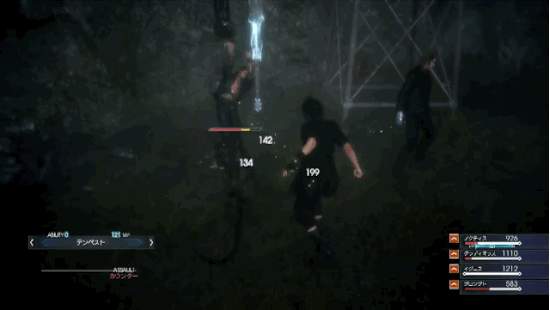
I only wish it nailed principled combat like the VII Remake did.
Fine. Alt-tab to Wrath of the Lich King, released in 2008, and shamelessly re-released... but all the same, still what I find to be the best implementation of the MMORPG? And it would seem I'm not alone in that sentiment.

Why is that?
God be damned if XV isn't a visceral game though. The Luminous Engine is a technical tour de force, and combined with strong art direction it's truly a feast for the eyes.
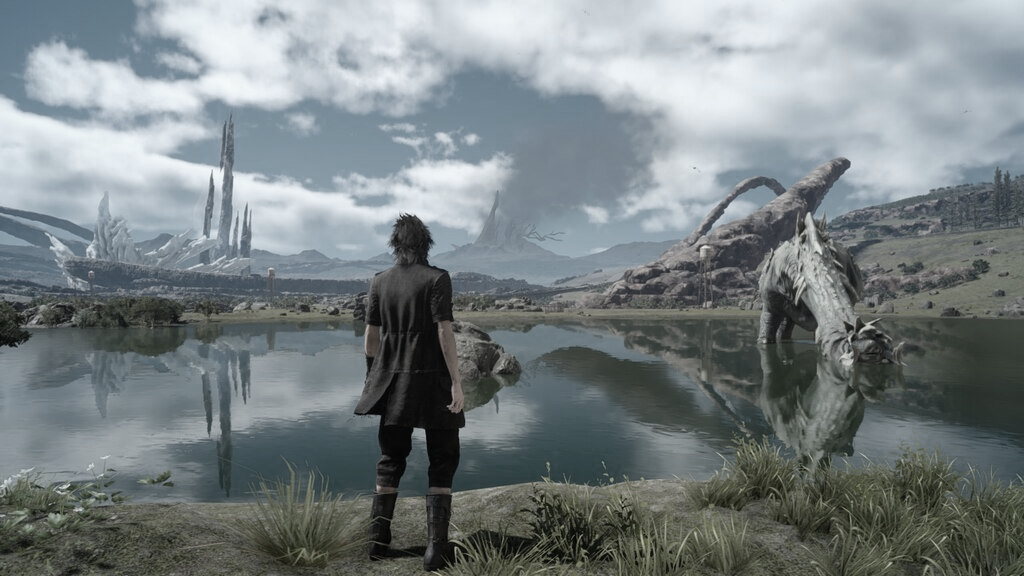
Not to mention that we're also treated to a soundtrack nothing short of stellar from Yoko Shimomura. Here's something of what would accompany your pseudo-combat adventure.
I mean, does anything else about the game I'm playing even matter, while being exposed to this? An intriguing notion. Feel free to leave it running as we continue, so that reading the next few blocks of text becomes quite the dramatic ride.
All that said, the game should, at the very least, be a far more immersive RPG experience than its predecessor...
...should it not?
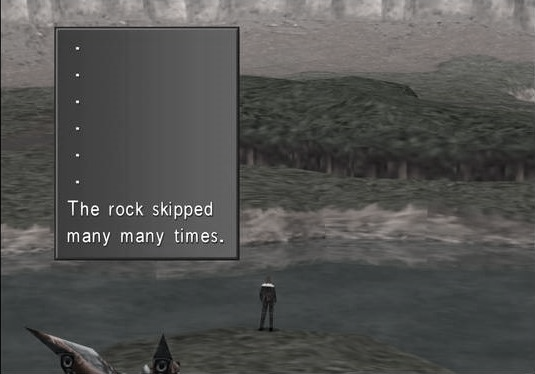
There's something so charming to it, isn't there? What, exactly, is that something?
A 'soul'?
Comparisons aside, I thoroughly enjoyed the newer game, and think it most definitely has 'soul', despite what it lacks in narrative. What I found to be the most gratifying experience within the game was the secret dungeon, which certainly caught me off-guard. We'll touch upon that later too. Last year's Elden Ring, as well as the rest of FromSoft's releases, need no mention. These are AAA games that are anything but 'soulless'... On a side note, I feel that the progression of FromSoft games, from one to the next, is something out of a parallel universe where the quality of the RPG experience progresses and one-ups itself like it's very well supposed to. Still, among Souls fans, many continue to champion DS1 as the best Souls-experience. Why?
I've chosen XV as my example for a AAA release because it's a great, highly immersive experience - just victim, in my opinion, to being less of an immersive RPG experience than the greater part of the releases that preceded it.
A growing perceived soullessness in the AAA RPG, in general, is undeniable: we can agree on that much, I hope? I'll refrain from slander and naming names, except to make my point.
All this is not to say that my current project is meant as a somewhat vitriolic attack on the industry. I suppose it's just one of the many ways I like to view what I'm working towards sometimes: an attempt to deliver more with less, and prove a point. To deliver a fervent "fuck you and your multi-million-dollar defecation" to the wind. But that's been said and done time and again, excellently, by our beloved indie devs. Admittedly, I do strive to match AAA-polish as part of that sentiment. But my main motivations happen to be elsewhere.
The greater purpose of my project is something I cannot reveal, but I assure you that it is in fact... wholly vitriolic, and far more nefarious than any money-grab.
UNSUSPECTING READER: Profit-driven corporations, profit-driven mechanics pushing microtransactions, games as a service, non-gamer developers, yadda yadda, inter alia. This is trite.
Correct, my dear reader. These remain issues of great consequence that warrant continued discussion. But I'm starting to believe that it goes a lot deeper than that.
My belief stems from a yet unripe notion - more of a perspective really - most relevant to the RPG, that we can call:
THE METAPHYSICAL GAME
I'm sorry to say that it's not as groundbreaking as it sounds. I think anyone who's played any game is aware of it's impact to some degree... without actually being aware of its presence as part of your experience. I think a failure to tap into this metaphysical game may be a key reason for the perceived deterioration in the quality of the RPG... especially for those who played them 'back when games were just better'.
Let us begin, here, an extended dissection of 'just better', or 'soul', or any other empty term used to refer to the same ill-defined quality.
Yes, it's quite the rabbit hole, as you'll come to discover.
Consider the experience of reading the written word, even something as simple as:
RAIN
READ IT AGAIN, then CLICK ME
This is naught but four small gray letters rendered on your screen. But I can guess, with great certainty, that in the parallel imagination-driven experience, that plays something like an invisible film in your mind... it's now RAINING. I've just reinforced it, so it's probably raining a little harder now. This may seem quite obvious to you: "don't think of a PINK ELEPHANT" - you've seen this party trick before. Or, conversely, it may be that you're finding it difficult to draw your awareness to it, and pinpoint where exactly this rain occurs. Each of us is captive to a unique conscious experience, I suppose. If you've read this far down into an itch post, you're probably either drunk, high on something, or both, which would mean that the rain's probably coming down on you pretty hard. I believe this mechanism, ever-active regardless, to be some facet of what you would call your imagination. An automatic mechanism though: an imagination-machine. I understand that it's this imagination-machine that allows us to even read in the first place, automatically extracting for us meaning and imagery from the written word. I don't have much background in the cognitive sciences, so I may be stating the obvious here to some, or exaggerating something obvious into some kind of revelation... but let me continue.How does this apply to the video game? I don't think it's a stretch to say that the exact same mechanism responds to any visual, or any component of a video game, in fact. While you interact with the material game, you experience a metaphysical one in parallel to it, but subconsciously, to the extent that you can never be fully aware of what I would define as a highly imprecise and rapidly mutating inner experience.
Let's take a closer look at a meme that you're probably familiar with, shown in Figure 1.
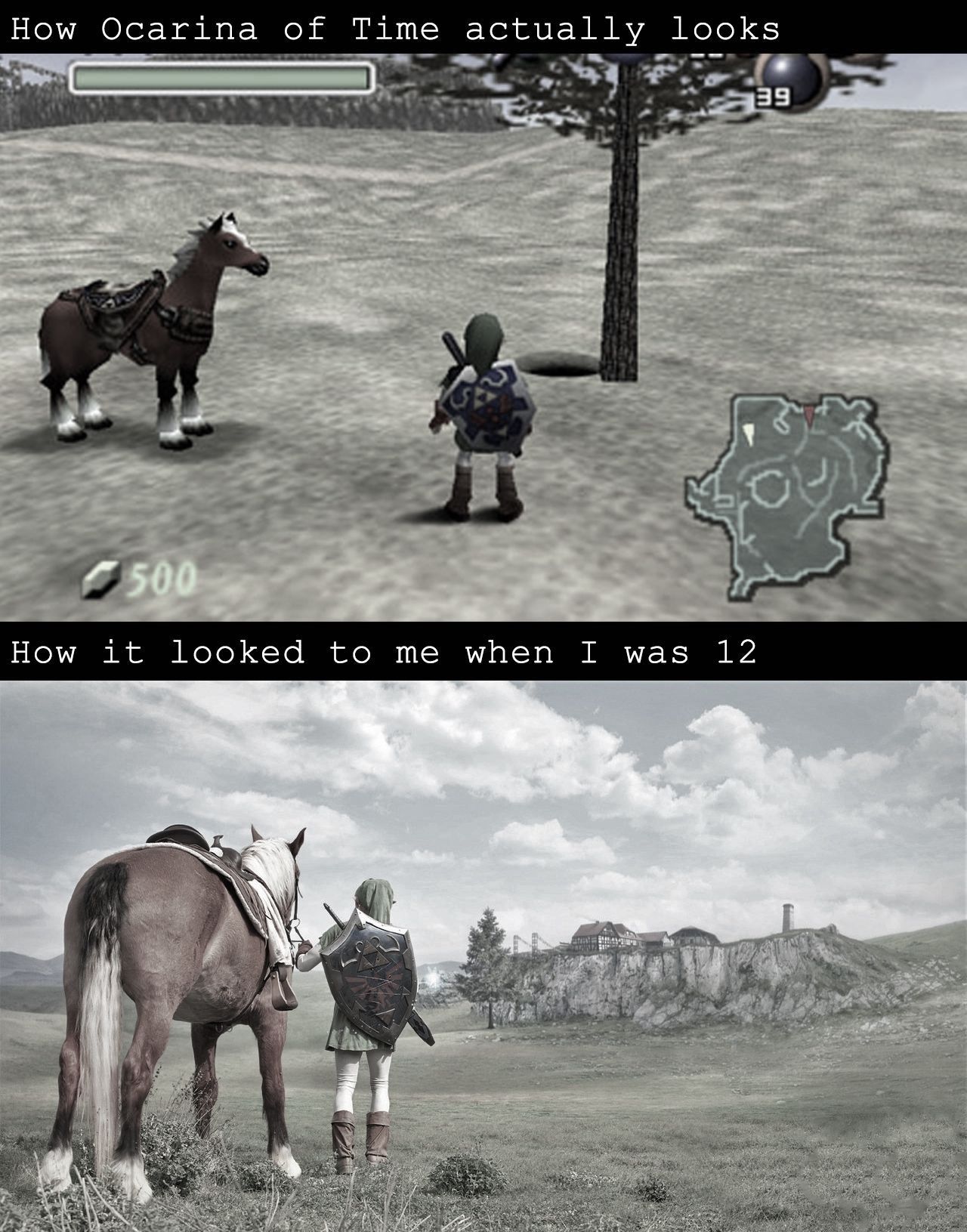
You get the basic idea. All I ask of you now is to reflect upon the idea of your memories of a game you played in the past... actually being of an ill-defined 'metaphysical game' running in parallel to the material game engine. Assuming it exists, and that the comparison above is not a warped memory, but instead an entirely real and highly robust phenomenon taking place during gameplay... I ask that you reflect upon which of the two you suppose better defines what we call the 'player experience'. And next, to reflect upon what a visual even is, truly, and the purpose of a video game's visuals. The ludicrously simple N64 render feeds what is the metaphysical game with tremendous power, and the lower image becomes what you actually experience playing the game. Sorcery?
A little unsettling, isn't it? You were being deeply manipulated by what you thought was just a moving image and some sounds.
It's not: the material game is just a driver for an experience much more profound. Or it should be, in order for the game to be any kind of high-level, transcendent experience.
I feel that the advancement of graphical fidelity may be of critical detriment to the quality of the metaphysical game, and in turn the player experience. I feel, that by this phenomenon, it can in fact be harmful to the player experience for graphics to lack the qualities, or meaning, that the imagination-machine can interpret better than it can fabricate... in the same vein of the book usually being a more immersive overall experience than the movie. If you're going to render something with your engine, instead of allowing the player to subconsciously fabricate it... it better be very meaningful, or else it's a downgrade. The same goes for the movie-adaptation.
Now: is the little Hylian Shield on my screen rendered in vivid detail, dents and scratches and all, it's edges reflecting the sunlight? Clearly not. But it may as well be: I'm subconsciously, and automatically, adding these details myself, and they are very much a part of my experience playing the game. I suppose it could be that I'm just super imaginative, or high as a kite. Or it could be because I can hear my shield clink as I move, layered above the soft pat of my footsteps - and so entirely emergent from Ocarina of Time's impeccable sound design.
Let this be an integral side note that, by this perspective, an N64 can easily triumph over cutting-edge UE5... in every single aspect of what makes a good player experience, including player immersion. That is, provided that the greater freedom for imaginative fabrication, granted by the simpler graphics, is shaped by the other components of the game that directly target that fabrication.
Revisit Ocarina of Time, and the graphics may seem jarring to you at first. But sustain your exposure to it... and you'll find yourself quickly falling victim to a scarily powerful immersion.
CAN WE USE IT?
DOUBTFUL READER: Sure Payl, a sensible perspective, if a little too inherently obvious to be insightful. But hold on - assuming that the graphics are meaningful and well-purposed... shouldn't better graphics mean MORE meaning conveyed to the player?
Correct again, to a degree. I start as a Vagabond in Elden Ring, and emerge from the cave into the beautifully-realized Limgrave. I notice the very subtle movement of the Vagabond's cloak, mimicked by the grass that floods the screen - blissfully unaware of an encroaching death-by-impalement. My texture quality is set to Maximum, so I can also see and note the detailed roughness of my cloak really well.
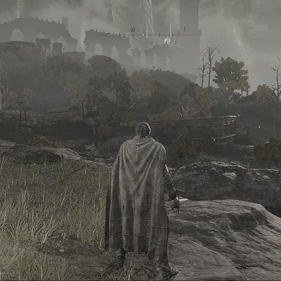
Let us try to give some definition to the indefinite, and read the possible 'output', if you will, to the player's subconscious metaphysical experience at the gameplay moment shown in Figure 2 - an experience likely to have become quite highly dopaminergic.
[Stunning Limgrave Rendering]
Wow, I'm a badass Vagabond, and I'm standing over this beautiful, grassy, rocky landscape.
[Highly-Fidelity Cloak and Grass Movement]
Oh, a gentle breeze. I can almost feel it... it's a little chilly here, isn't it?
[Detailed Cloak]
My cloak is dirt-stained, ragged; I've surely been through the ringer in my past lives. I'm tough, hardened by time.
A super effective conveyance of information to the imagination-machine - a machine that may start to take a life of its own in an extrapolation, filling in even more meaning to the perceived environment, without the player being aware of it. It could only be improved by my Vagabond remarking that the wind's howling, to reinforce that breeze.
Would the player's environment and character immersion have this much nuance if FromSoft decided that 'graphics don't matter to gameplay', as many a clueless player would preach?
We're discussing the RPG: this here, what I would identify as a function adding viscerality to the metaphysical game, are as much a part of gameplay as the game's mechanics, as I see it. I hope you can consider that, and agree that it's a valid assumption.
Note that I've so far made reference to two different visceralities, one for each parallel game. Looking at things the way we have been so far, as in, with the metaphysical game being more important in the dictation of the player experience - the rules of game-world design are changing.
There's far more being fed to us at this moment in Elden Ring than that... but let's run with these three conceptions for now, and label each as a building block towards a coherent metaphysical game. It's my personal belief that it's always a bad idea to identify something to be under an exclusive category, but we can entertain it, if only for the sake of clarity. Whether these labels are truly accurate, or the best choice of labels, shouldn't make that much difference to the bigger picture.
[Visually Stunning Limgrave Render]
Wow, I'm a badass Vagabond, and I'm standing over this beautiful, grassy landscape.
{Place Establishment}{Artistic Quality}
[Highly-Fidelity Cloak and Grass Movement]
Oh, a gentle breeze. I can almost feel it... it's a little chilly here, isn't it?
{Environment Detail}
[Detailed Cloak]
My cloak is dirty, ragged; I've surely been through the ringer in my past lives. I'm tough, hardened by time.
{Character Detail}
Let's define them as follows:
{Place Establishment}
Anything that gives me information about the world, or setting, that I've jacked into. This would include 'visual storytelling', or informative text.
{Environment Detail}
Anything that adds nuance, or fidelity, to my imaginative rendition of this world or setting. This is where graphical fidelity can shine.
{Character Detail}
Anything that adds nuance, or fidelity, to my imaginative rendition of the character I'm playing as. Graphical fidelity can help here too.
{Artistic Quality}
Using this label leads us to a greater question... what is art, and why is it so pleasing to our eyes? We can skip the philosophical debate, and make this loose assumption.
Any image or arrangement of detail that has within it meaningful features, something like a packet of information to our subconscious, except more abstract than plain information. Something that triggers a feeling?
One more we may use:
{Gameplay Information}
Anything that gives nuance to my imaginative gameplay experience. That should suffice, for now.
And one more to address, that we should be careful not to include in arguments.
{Nostalgia}
Similarity to a game of the past-era, which resurfaces in the subconscious whatever positive emotions were associated to your experience of that past-era game.
It's a great feature for a game to have, but for the purpose of direct comparison, we should not let it influence our assessment.
Join Payl now as he conducts an investigation. I happened to have made it a high priority to implement at least basic hair and cloth physics into SANDS OF SODIS, chasing this nuance to the environment while failing to really understand it. The engine wouldn't be able to handle any real physics, but I managed to bake it into the movement animations.
Most notably, I was struck by how the fidelity of the movement did not matter much to what I perceived to be the quality of my metaphysical experience during playtesting. It seems negligible - as long as the movement was there, acting as some kind of trigger, I could replicate almost the exact same 'function' and 'output' to the comprehensive experience... for myself, at least.
It's difficult to see the subtle movement while idle, as it is currently - so let's take a short walk - Figure 3a below. We're currently on a quiet, peaceful island called EREDEA. It might need some BGM; thankfully, there's no grounds to sue for how I'm about to cheat. My OST is piano-based, close enough. Add Ocarina of Time's clink to this: you thought of it and heard it earlier, and I'll be sure to include one.
[Flat Textures, Basic Environment... + Beautiful Music and Clinking]
Wow, I'm an armored knight, walking over this beautiful grassy landscape.
{Place Establishment}{Artistic Quality}
[Super Basic Cloak and Hair Movement]
Oh, a breeze as I move. I can almost feel it... it's a little chilly here, isn't it?
{Environment Detail}
Vile trickery. This (far from prefect) demonstration brings into view the crux of my ramblings. We've affirmed the metaphysical game, running within the player, and we've affirmed that it's highly dominant over whatever we're rendering on the screen, in the context of the comprehensive player experience.
I believe attention to the power of the player's imagination could be the essence lost as games became more and more materially substantial.
You noticed that we're missing something in our replication: the {Character Detail}. But now that we understand the way things are a little better, it's no issue.
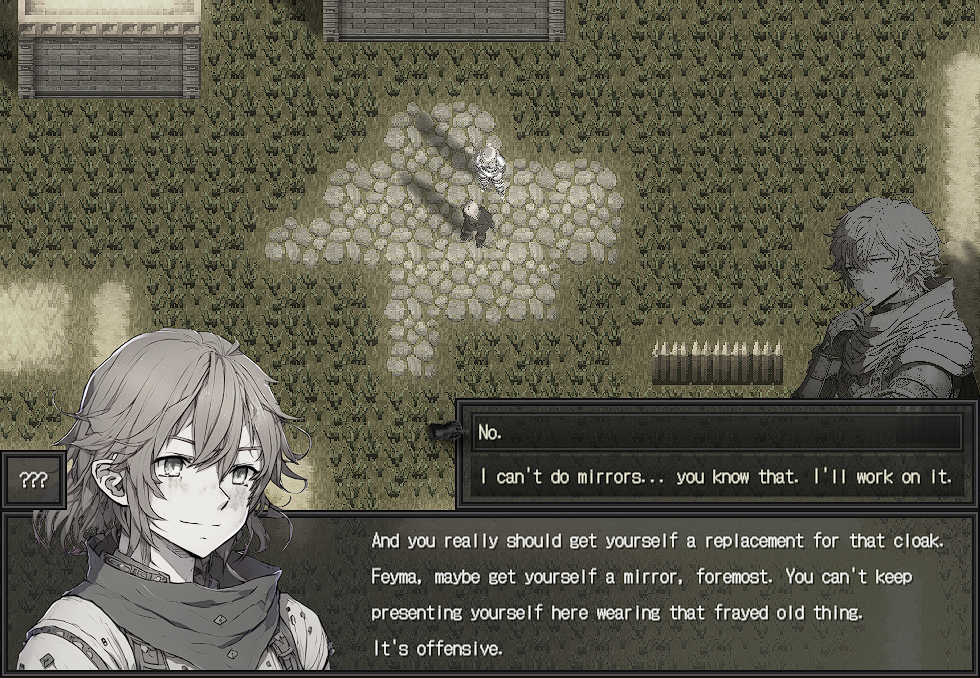
Could the fact that I introduced the environment to you as quiet and peaceful... influenced your perception of it, to some degree, in studying the figures above?
GOLD, TARNISHED
On the subject of the written word, I invite the reader to examine Figure 4, the recent release Roadwarden from Assemble Entertainment. I've yet to really sink my teeth into this one, but I've played enough of it to commend the surface-level experience.
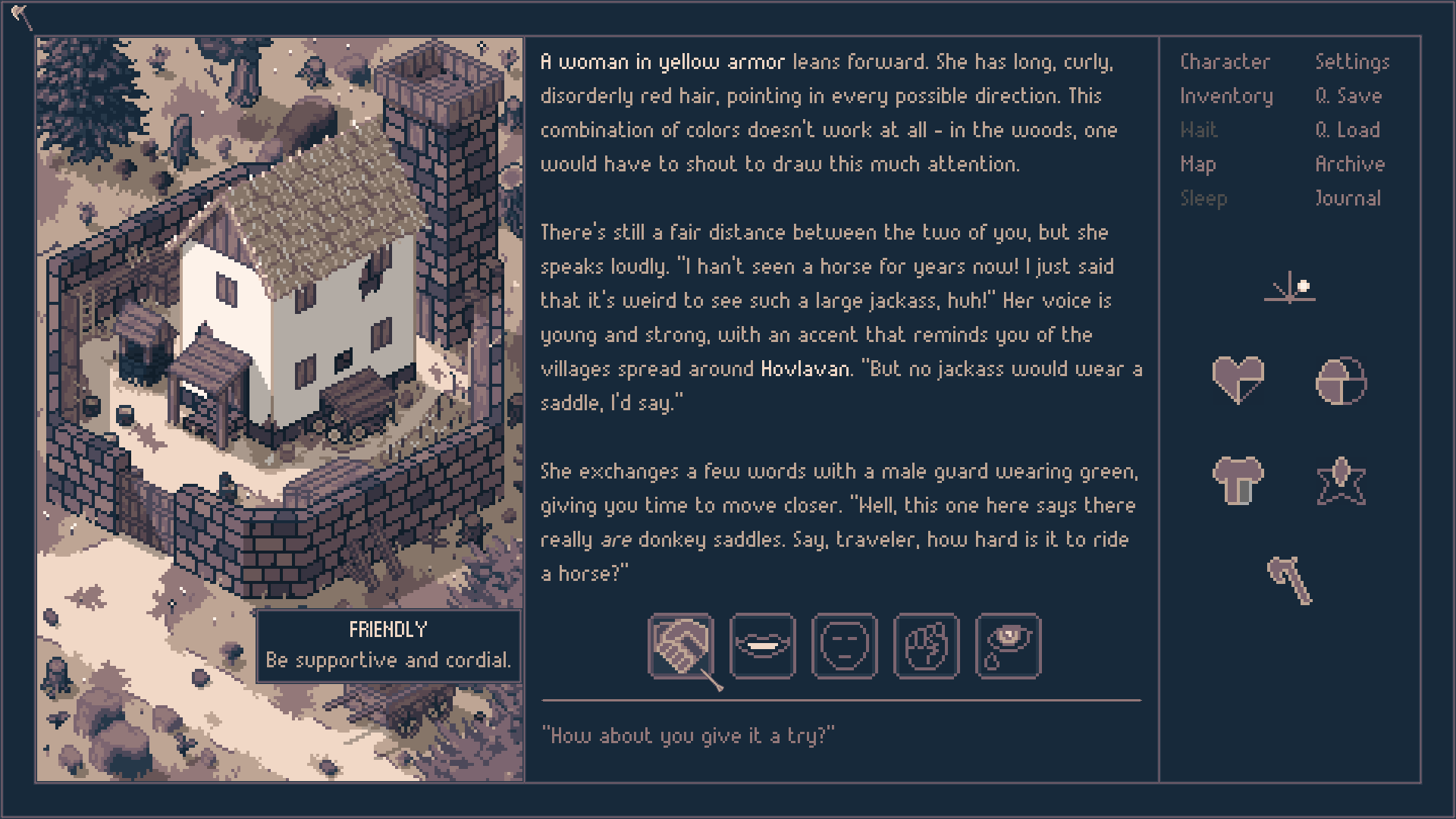
In case it's not obvious, Roadwarden is an homage to the earliest form of the video-game RPG, that being the text-based RPG. There is no rendered game-world: the game is entirely contained to a text-box, and the UI elements that surround it. But it's more than enough to present all the information (the triggers) necessary for an immersive RPG experience. Notice the Character Details on the left, telling me how I'm doing. Or the powerfully realised Environment in the high-quality writing and thoughtfully designed image.
On the subject of the earliest forms of the RPG, let's refresh ourselves on the celebrated tabletop RPG Dominion. Where should we start?
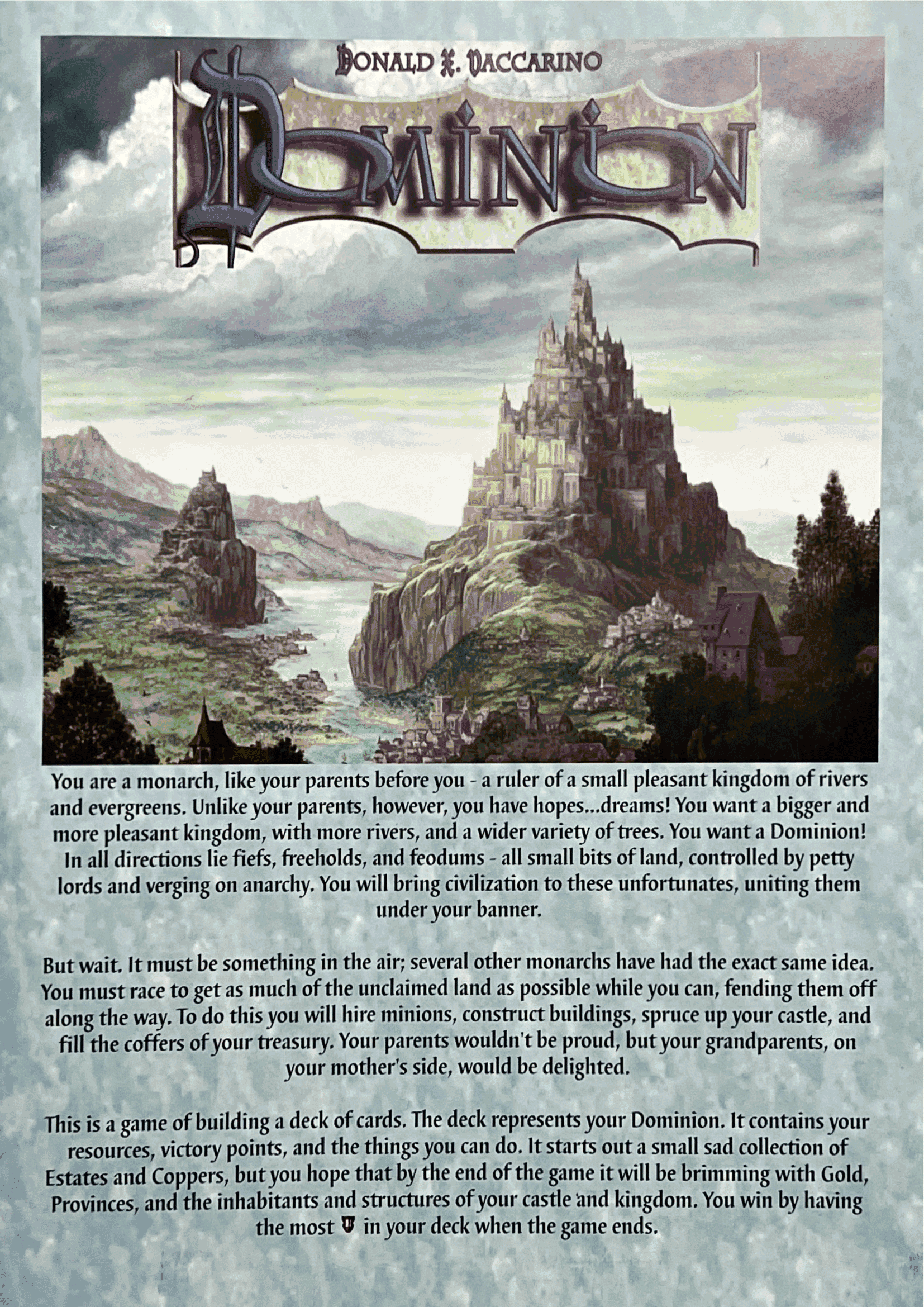
This game is manifested solely from an arrangement of cards, isn't it?

But you're mistaken: these are not cards at all. What may look like kingdom cards are, in fact, buildings or pieces of land, and what may look like a deck, the one I build using them, is in fact my Dominion. Even if I didn't read the manual... it's evident that this here isn't a card. It's a stack of gold. Look, it's right there. I'm rich.
There is much I could say about Dominion's gameplay, and why I consider it countless levels of an RPG experience above most video-game RPGs. But we're keeping gameplay as a passing mention, for now. I'll leave all that for the deck-builder study I'm planning to publish, at some point during development.
For our next case-study, let us return briefly to the dead and buried genre that is the MMORPG. Shown in Figure 6 is my MMO of choice, notorious for it's messy, bloated UI...
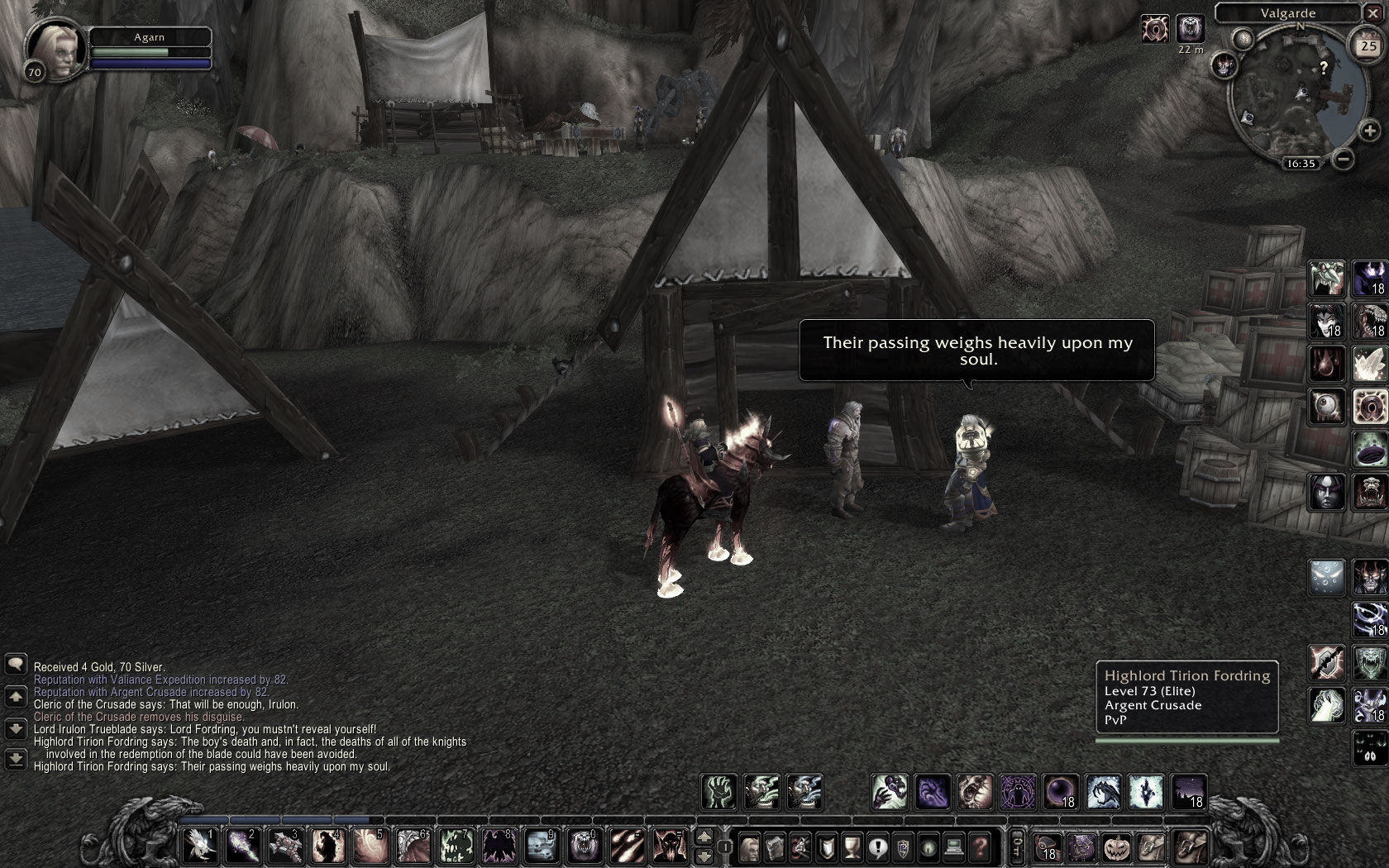
...in other words, it's secret weapon of RPG immersion.
The graphics are laughably dated. But do they really detract from the player experience... at all? Notice how the stark lack of environment detail can, in fact, highlight, and draw attention to, a meaningful placement.
[Towering Stack of Crates, Red Cross]
I see that this camp is used to store medical supplies, and a lot of them; this is a time and place of battle. I can sense the unrest in the air.
{Place Establishment}
I feel that the rendering as a whole also hits us with some more {Place Establishment} and even {Artistic Quality}. It's a stylized world; I'm most certainly in Azeroth, and not in my backyard.
There's undoubtedly {Nostalgia} too, for myself at least: I've been here before, in Warcraft III. But let's try as much as we can to stay objective to that.
On to the secret weapon.
[Faceplate: Face, Level, Health, Mana]
I am Agarn the Warlock: that's why my horse is on fire. Far from my full potential, but handsome and blonde-haired nonetheless. I'm a little hurt at the moment, though.
{Gameplay Information} {Character Detail}
[42 Simultaneously Visible Abilities and Consumables, Each with Unique Art]
It's a good thing that I happen to be a learned and extremely capable Affliction Warlock - a force not be reckoned with, lest I unleash my overflowing arsenal of curses upon you. But more importantly, let's find a victim to Drain Life from.
{Gameplay Information} {Gameplay Information} {Artistic Quality}
[Minimap]
This modest camp is situated on the coast of Valgarde, it seems. There appears to be a dock here, for ships to come and go, maybe with supplies to fuel the nearby battle. Also, I'm owed a quest reward nearby, hurrah!
{Place Establishment} {Gameplay Information}
[Speech Bubble, Tooltip]
"Their passing weighs heavily upon my soul", says Highlord Tirion Fordring, soberly. This is no peasant: an NPC with the level of 73, so he's actually quite a bit stronger than I am. But who does he refer to?
{Place Establishment}
[Message Box]
Here it is: he's conversing with Lord Irulon Trueblade, referring to the death of many a knight, among them a young boy. If only they knew that the fiery-horse-mounted figure before them can, in fact, Resurrect.
{Place Establishment}
Am I familiar with the characters that are the two supposed Lords? No. Do I care? No. I'm immersed. This is highly potent {Place Establishment} whether I'm familiar with the background lore or not.
I'd like to note that this is, genuinely, a random screenshot of the game I found on Google.
Also, I think there was a small point made there that might need a little more emphasis. How about this?
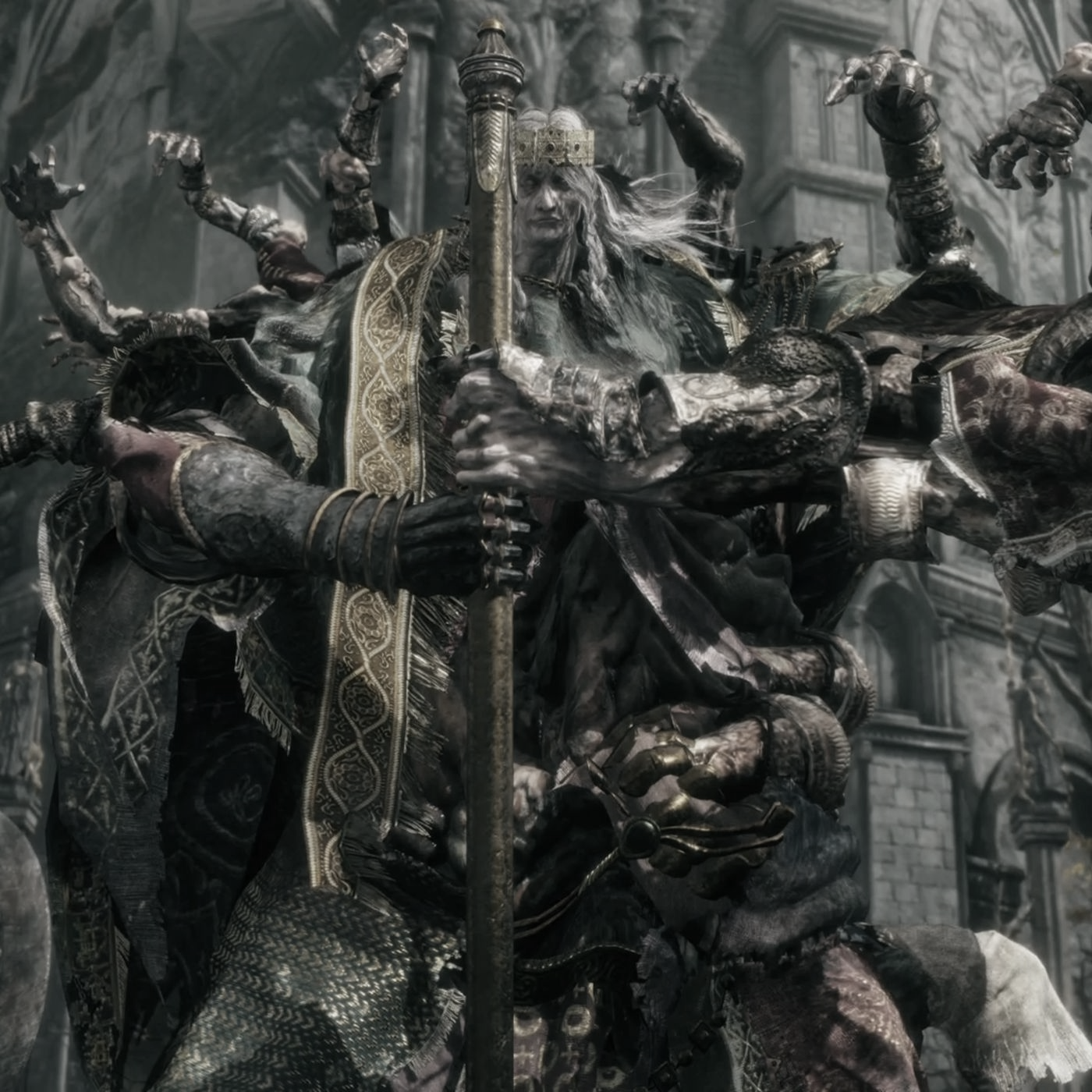
Do I need to watch a four-hour long lore video on YouTube, investigating item descriptions, for this boss design to powerfully stimulate my imagination-machine? The health bar on my screen says 'Grafted'. I can connect the dots, sadly.
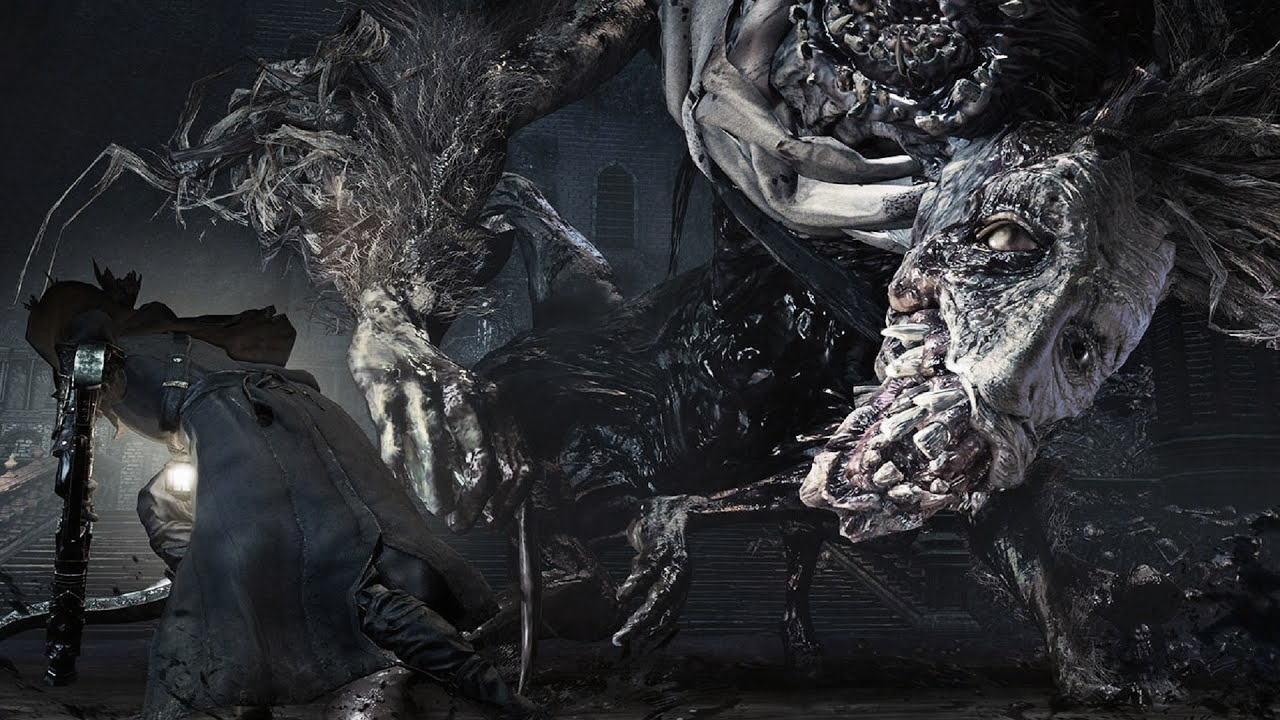
Back to Wrath. In case you're not aware of it, most players of this game don't actually RP to the extent that our hyper-imaginative player above does. But I hope the reader can see the importance of what I'm trying to convey here: this is a subconscious effect, exacted upon any player exposed to the UI.
Notice the icon-art for the Drain Life ability that we've resolved to use. An agonized face, with 'Life' streaming out of it's eye-sockets and gaping mouth.
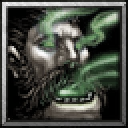
That's what happens to my victim when I use that skill... despite the animation for the skill being not much more than a green glow. Also, that's how 'Life' looks like in this world, and it's a world where one's 'Life' can be sucked out of their face. Unless that's me in the icon, and it's the other way around. It's no Sistine Chapel; this blurry mess is not at all of a high material artistic quality. A potent {Artistic Quality}, distinct from that, as well as some {Place Establishment}, is translated to our metaphysical game though; it's meaningful. An effective trigger, reinforced by the fact that it's a permanent part of what I see on the screen.
Here's the modern blockbuster MMO.

Okay: our imagination-machine is being fed a whole lot of {Environment Detail} and some great {Character Detail} to work with.
With a little extrapolation, there can be the start of a strong immersion here, into the game-world, or the rendered environment, specifically. We'd be helped by high-fidelity movement in the foliage, good sound effects, and a super-cosy soundtrack... and even the minimal UI, which can play to that advantage.
{Detail}, {Detail}, {Detail}, {Detail}, {Detail}, {Detail}, {Detail}, {Detail}, {Detail}, {Detail}...
Some {Artistic Quality} too, in the current view of the environment, for sure. It would make a nice painting, wouldn't it?
But where is the {Place Establishment} to tie everything together, at this moment in gameplay?
What's distinct about this village that I've happened upon? It has to have some distinction, or importance to the world... or else it's just an {Environment Detail}, isn't it?
And so what is the overall imagination-driven RPG experience that arises from all this, at this moment?
Also, bear in mind that by defining the metaphysical experience as machine-driven, we should also assume that this machine, like any other, has a capacity. I would assume that if we flood it with a certain kind of information, we could be detracting from the awareness of other sources of information.
I hope you see what I mean when I say that it's possible the multi-faceted mechanism of true immersion are being neglected in the modern RPG, even in a game selling itself as an immersion-focused MMO experience. Pull me strongly into the environment, sure. But what am I doing here, in this well-realized environment? What should my imagination-machine be extrapolating towards?
I've heard criticisms of New World of being too much of a 'walking simulator'. I would say that's a little harsh, given that it's meant to feel realistic and simulator-like. But I would note that it could be due to having too many moments in gameplay such as that shown Figure 7a, where there is hardly enough {Place Establishment} fed to the subconscious to elevate 'walking simulator' to 'exploration' or an 'adventure', as it should be.
I've heard criticism of New World as devoid of an 'art style', in being... too similar to a backyard, maybe, and in turn 'soulless' - but I would disagree. I think the game-world does have something of a consistent art style: realistic, medieval, historical... pirate-themed? It's not especially unique, or of significant {Artistic Quality}, but it doesn't have to be to achieve immersion. It doesn't push much, if not any, {Place Establishment} from this choice of art style to our machine though, and that could be it's problem. Bring your attention to the ability icons shown. I fished out the high-resolution ability icon for Leeching Bolts, a passive skill pertaining to the Void Gauntlet, and of somewhat similar function to Agarn's Drain Life. Compare.


Whatever, let's keep playing. I've decided on the Throwing Axe as a better alternative to the Sword: we'll be spending a good portion of our play-time on this screen, training our familiarity with the weapon, I suppose.
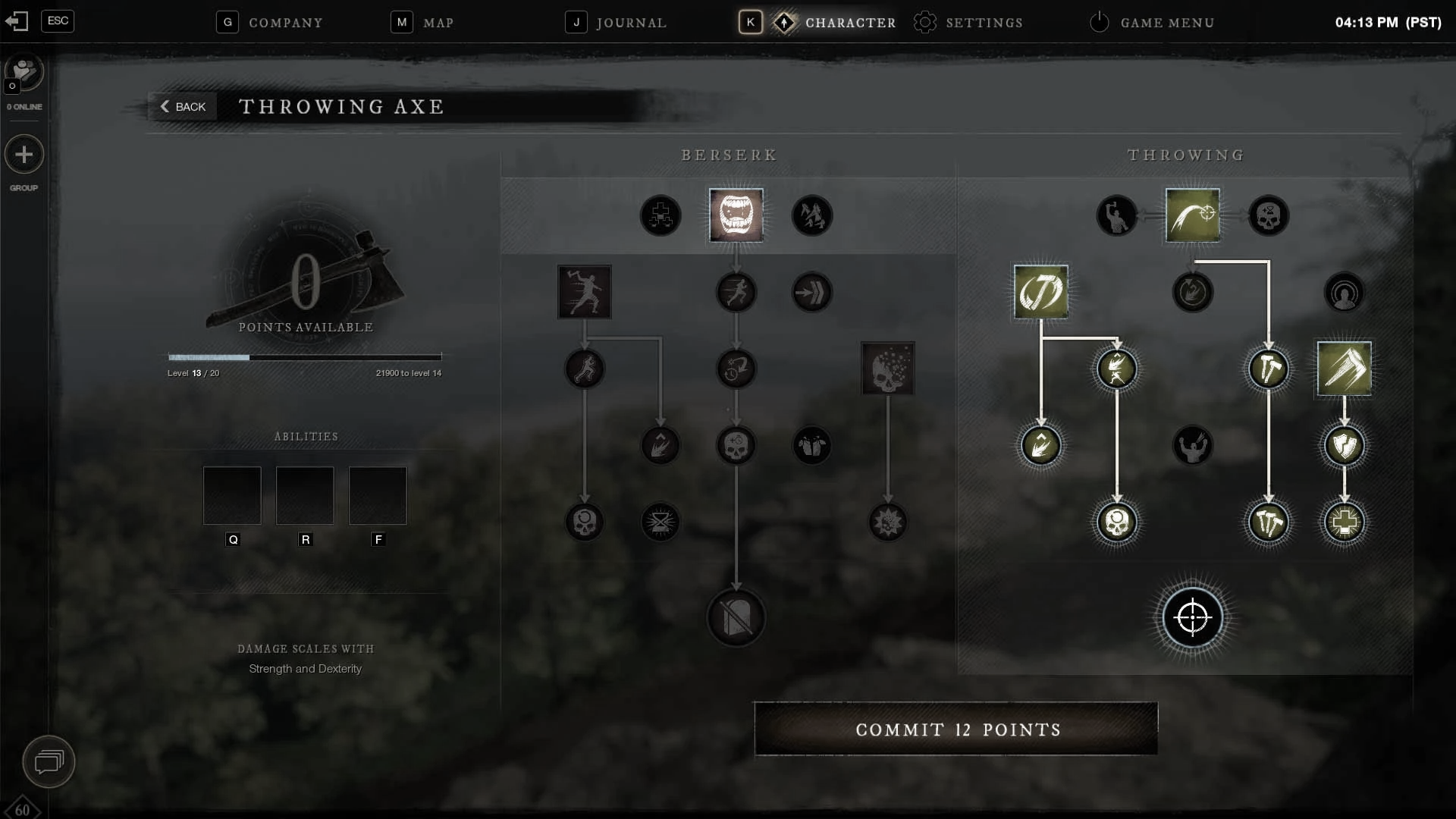
I'm being harsh too now: it's clear that a lot of hard work's been put into this menu. Pirate-themed font? Check. An icon representation of the weapon I'm training with, detailed with a very cool spinning magic circle behind it, possibly representing my analysis of the weapon as I train? Check. It's quite good. Even though I, admittedly, really dislike this game's UI... it would take me days, at least, to design and code a replication of it. Notice the many other exquisite details on the screen, the emissive glow to the icons and buttons and the watercolor-esque background elements among them. But what do these extra details actually tell me about what I'm doing here?
What is the overall imagination-driven RPG experience that arises, while using this menu?
I believe that if the menu was simpler, even if it was condensed into a plain black window, for instance, and not pushed as a full-screen experience... it would be a lot less detrimental to my immersion in the RPG.
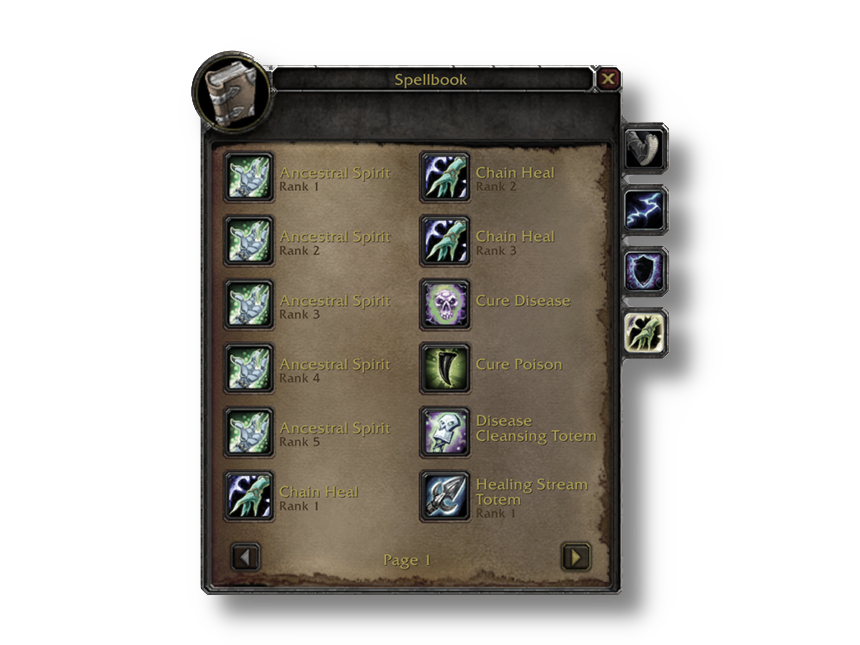
To review my abilities, I produce my SPELLBOOK, which is evidently clear to be a SPELLBOOK. A header-icon showing a Book; that must be my SPELLBOOK. I hear a page-flip sound, and the Spellbook manifests itself on my screen as an overlay: no fade-in animation, no camera movement, no change to anything else currently visible on my screen. It's almost like I'm just... reviewing a book that my character has on his person. There's no change to my mostly flat-textured character. But he DOES carry a Spellbook, I know that already - it's THERE on the icon bar, permanently visible, and what I see now is because I clicked it.
I can GIMP an improved version of this static Spellbook window in... ten minutes, being generous?
...
But meaningful information need not come from text boxes, UI elements or in-game menu screens. This RPG is of the action-based, minimal-UI, 'environment-immersion' kind. Much like another game that I've been playing... which actually has no UI visible at all, bar a similar compass, during exploration.
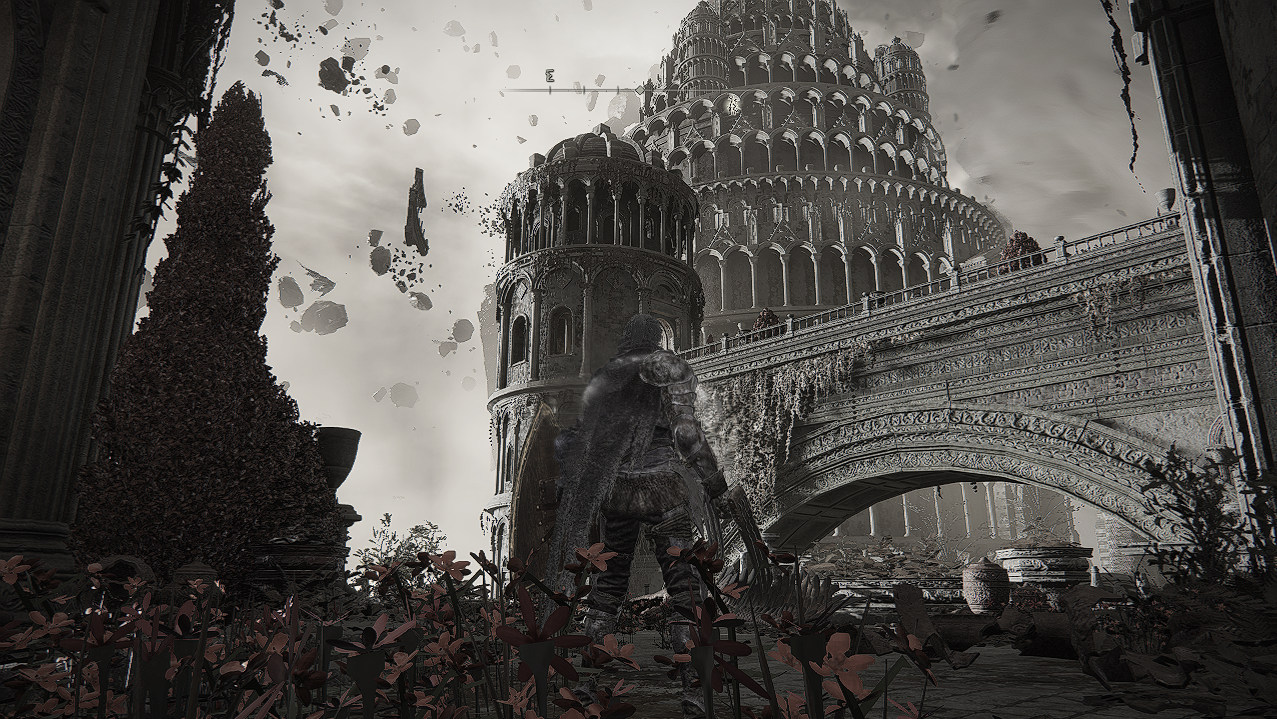
I said I wouldn't mention Elden Ring (I really did, didn't I) so we can stop there. Let's alt-tab to some other RPG. I'm working my way through a dungeon.
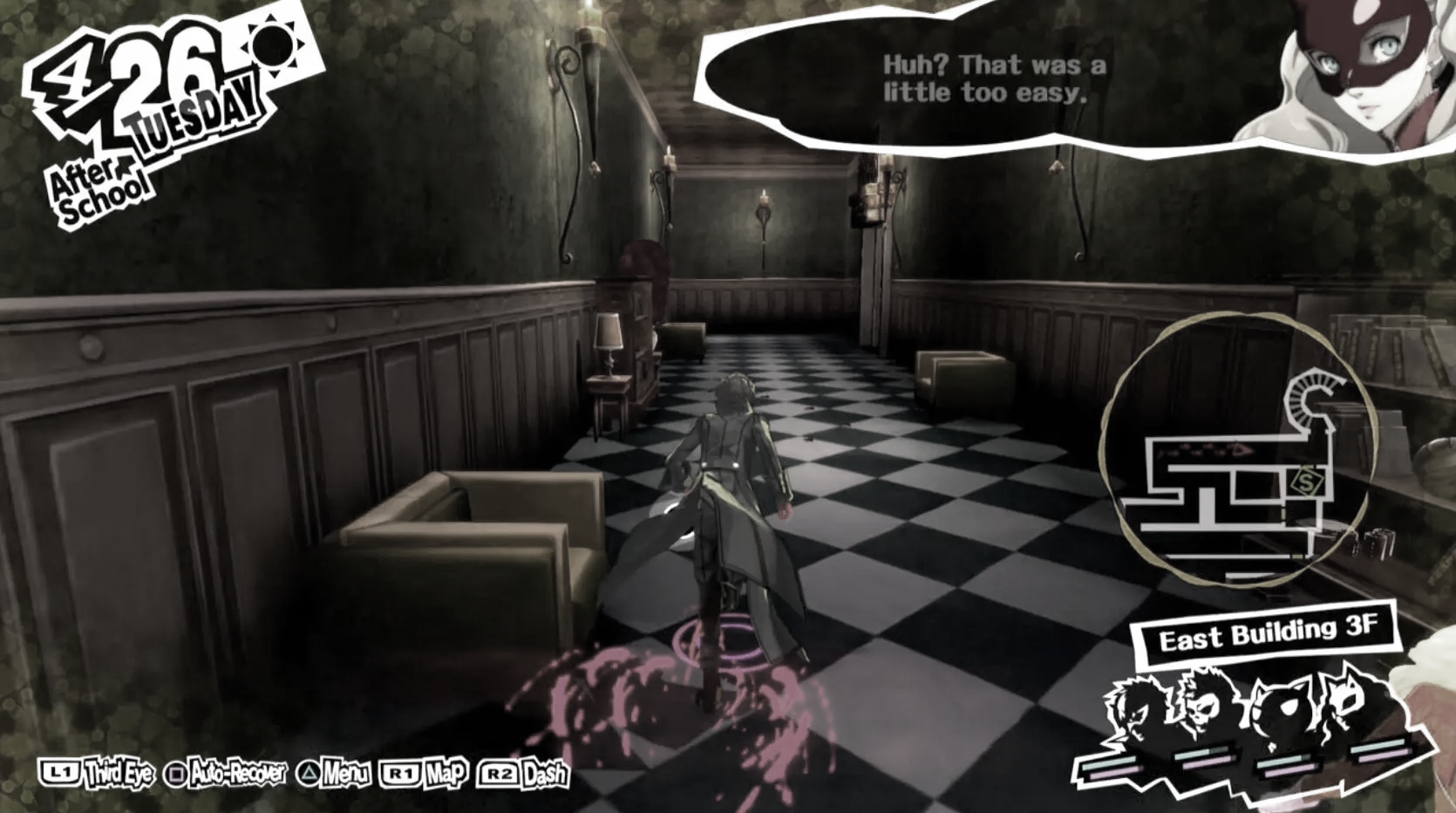
Flat, low-quality textures, empty square-corridors, janky movement... it may appear as quite the low-quality RPG, stylishness aside.
A lot like an N64 RPG. A lot like a PSX/Dreamcast RPG. A lot like an aged PC game.
A lot like it's highly calculated, and targeting an experience beyond the material game.
A lot like it's designed with an understanding that the player's imagination will fill in all the minute details to this corridor that it needs to, if it's stimulated enough.
A lot like what's rendered on the screen is instead a set of triggers, designed to push that stimulation, and enrich what is the actual RPG experience and the player's immersion in it.
Speaking for myself, it's starting to become a little more evident what makes one RPG so very good, and another disappointing in a way you can't really describe... and why the advancement of time and the perceived quality of games has given us more of the latter.
Here's an interesting thought: what if we imbued a certain UI, which feeds the player all the {Gameplay Information} and {Character Detail} that the metaphysical experience requires... with tenfold the {Artistic Quality}... tenfold... tenfold?
AMBUSH
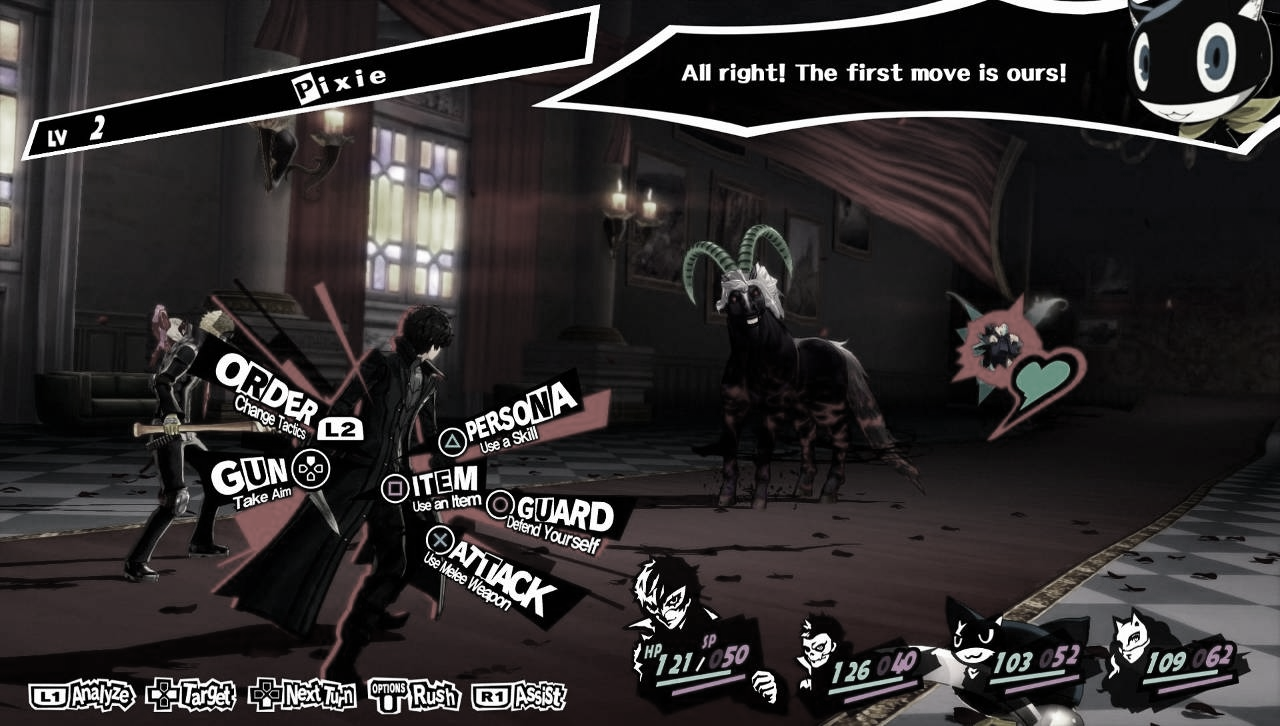
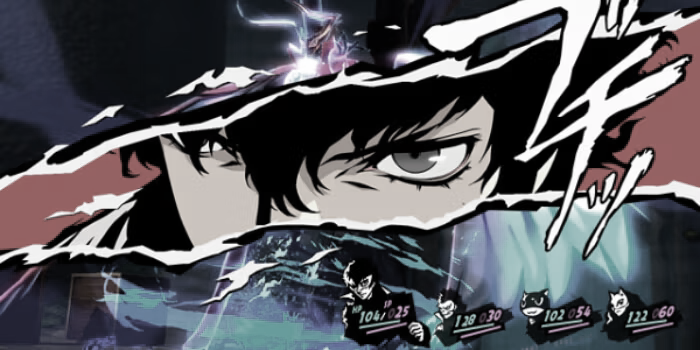
Silly pixie, shot dead by a replica. Now that that's over with, we should reassess our party's equipment. That's going to be on another fullscreen menu, isn't it... we're sure to suspend the violent, unrelenting stream of {Artistic Quality} and {Character Detail} for at least a moment.

I see this game as one of the strongest examples of the point I'm trying to make, and if you're a little lost now because you haven't played it, I apologize: I truly am sorry for you. Let it be our closing statement.
But you'll have to excuse me for a moment. I'm in a real ass-kicking mood right now, for reasons beyond me.
Our analysis of the RPG so far has most definitely been a surface-level one. You probably noticed that we've been avoiding discussion of what is likely to be the most important facet of the RPG, metaphysical or otherwise. That would be:
G A M E P L A Y M E C H A N I C S
You've probably also noticed that most of our discussion has been surrounding relatively modern games, and that we haven't really discussed past-era games all that much,
An exploration of mechanics warrants a much deeper analysis than the above, and I've decided it should be delegated as a separate write-up, under a different title. For that, we'll be looking mostly at combat mechanics, and our choice of case-study will err towards the PSX/Dreamcast era JRPGs that we've only made passing mention to here - something a little more relevant to my current work. We should leave a dissection of Dreamcast era examples for this follow-up post, with the important discussion of their mechanics as part of that. Did someone in the crowd say Grandia?
Oh, you thought this post was too long?
Before we say our goodbye-for-nows, we should acknowledge that all things must end as they begin, and touch upon how gameplay mechanics might concern the notion of the metaphysical game. Which bring us to:
THE PITIOSS RUINS
So, I'm cruising around Eos in the Regalia, within a completed save of some game, reflecting on a disappointing conclusion to what I felt to be an incomplete narrative. My Regalia happens to have been upgraded into a FLYING CAR, as a well-earned reward, I suppose, for my heroic capitulation to pseudo-combat. It's a high-altitude process of reflection now, as it should be.

Night falls, and I happen upon a secluded area on the lower corner of the map, where the game, strangely... allowed me to land.
Actually I was told to come to this exact spot online to find an item, and landed here with the full purpose of completing the dungeon. I was trying to make a story out of it for you, okay? There's no way in hell someone would happen upon it. The dungeon entrance is marked only by an elaborate stone construction, home to an elevator door that only opens at night. It's the beginning of what will become a very strong sense of I'm not supposed to be here.
{Place Establishment}
"Weird." says Noctis. And that's about it for the narrative context the player receives. We're now completely disconnected from the game's controversial narrative, and faced with... the unknown. No enemies at all either. Just this.


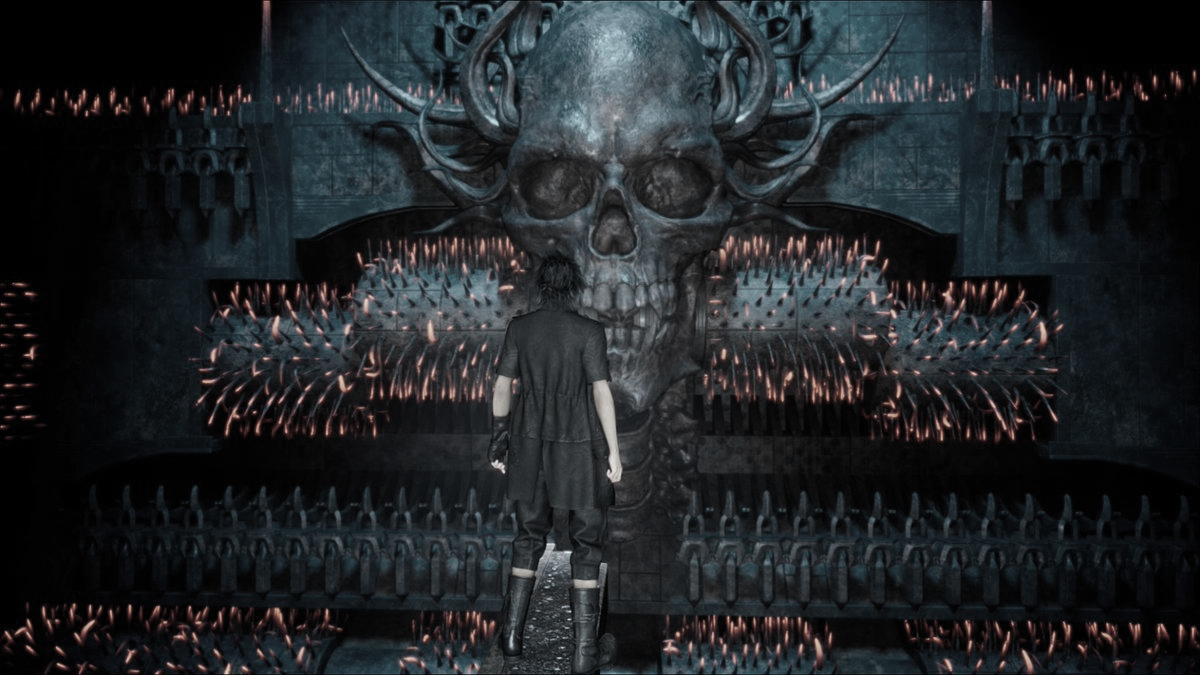
Ah yes Bowser's Castle just as I remember it.
Could the book-movie comparison we used earlier have something to do with less being more, regarding narrative?
Does DS1 come to mind?
That aside, the key point I wanted to get across showing you the Pitioss Ruins concerns the notoriously difficult platforming and puzzle-room challenges you face within. It's tedious, yes. But consider this.
FFXV has built within it an intricate, beautifully-animated movement system designed for game-environment immersion. It doesn't do much for shallow combat mechanics, or low environment-interactivity. But down here, in a place lit only by your flashlight, you are forced to pay the utmost attention to where your feet land for the platforming, and to the structures surrounding you for the solution to the way forward. You're forced into this immersion, and then force-fed the environment's obscurity and unsettling imagery... much like you would be in Elden Ring.
{Artistic Quality}, {Place Establishment}, {Gameplay Information}, {Artistic Quality}, {Place Establishment}, {Gameplay Information}...
...pushed by the environment, alone, alongside the high {Environment Detail}.
It's an RPG experience very much like the example we used to introduce the metaphysical game. One that begs the question of how game-elements should be prioritized to be cohesive with gameplay mechanics, in order to reinforce them to the player, and in order for the best version of the metaphysical game to come into realization.
But it's been a long night, and you're cutting into my precious hours.
----
----
----
----
----
----
Thought of one.
TLDR: When creating an RPG, consider the player.
The player happens to have an imagination. Empower it, instead of restricting it.
Writing, music, artistic value, meaningfulness. It's important.
Games from the past were forced to sell themselves on this quality, as opposed to the material, superficial quality too easily attained in our time. Appeal to the 'market', and set the bar lower, I tell myself.
Again, these things are probably inherent to the many indie devs much more seasoned than myself, but I figured I'd do my best to echo the message forward with this discussion, and hopefully with SODIS.
If you actually made it this far into my TED talk without skip-reading, I truly hope you've glimpsed within in it, for yourself, at least a sliver of something thought-provoking. I assume it also convinced you, with certainty, that Payl is not of sound mind. I plan to publish a few more of these during development, and stay in touch with my dear reader. I feel that above all, these recognitions, to whatever degree they are flawed or incomplete, give the WebGL-restricted developer that is myself, and many others here I would think, a sense of hope. Maybe, if I can fiercely divert my focus to the experience my code and assets can bring about within the player, it can match and even defeat the biggest of outing's from the yet-unenlightened giants. Maybe you can too, and we can turn things around together with a volley of stones.
I have all of that right here, if you'd rather that.
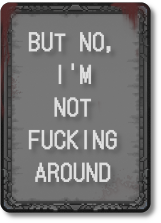
Sensationalism? Leave your thoughts, if you dare, non-existent reader.
This probably needs an FAQ.
FAQ:
BRACKISH READER: Who even are you, to speak on the game industry and game-design with such arrogance and feigned higher-understanding? The rules of game-design are changing because you said so? Your credentials? Do you have a PhD in something relating to game-design, to warrant this attitude, or for me to even bother considering your writing? Your track-record?
SILLY READER: ...is this a creepypasta, in disguise?
PERCEPTIVE READER: A direct manipulation of the player's imagination: a hypothetical 'power'. All well and good. But couldn't this go awfully wrong if a hypothetical developer decided to use this power of a forced immersion... to truly harm the player?
Good questions, aren't they.
SANDS OF SODIS
A Classic JRPG
| Status | In development |
| Author | PAYLHORSE |
| Genre | Role Playing, Puzzle, Survival |
| Tags | Atmospheric, Crafting, Experimental, JRPG, Psychological Horror, Surreal, Turn-based Strategy |
| Languages | English |
| Accessibility | Subtitles, Interactive tutorial |
More posts
- SOME CONCEPT ARTJun 09, 2023
- THE CARDS: Sources, States and StressMar 21, 2023
- THE GAMEDec 02, 2022
- An UpdateNov 22, 2022
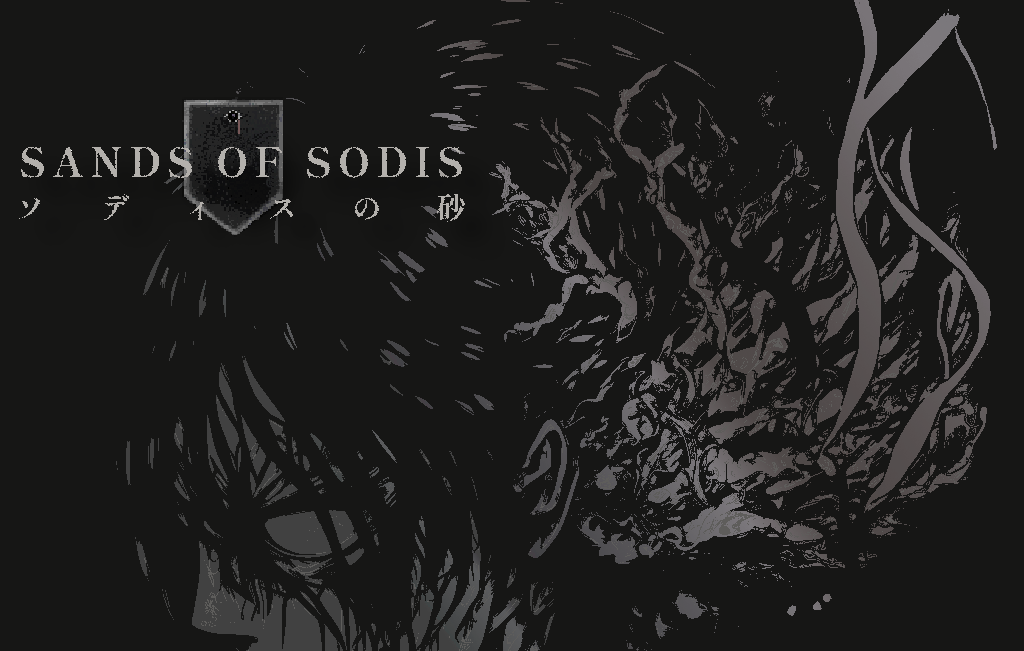
Leave a comment
Log in with itch.io to leave a comment.